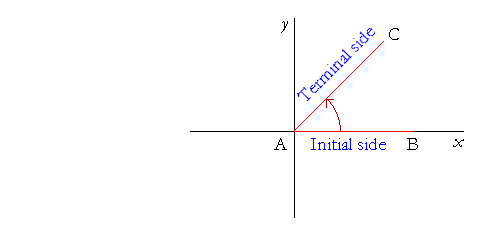Standard position

WE SAY THAT AN ANGLE is in standard position when its vertex A is at the origin of the x-y plane, and its Initial side AB lies along the positive x-axis, while its Terminal side AC has rotated. We say that AC has "swept out" the angle BAC.

If the terminal side AC has rotated in a counter-clockwise direction, we say that the angle is positive. While if it has rotated in a clockwise direction, as AD, the angle is negative.
Degree measure

Why choose the number 360 for the measure of a full circle, or of one revolution? What is so special about that number -- why not 100° or 1000°?
The answer is two-fold. First, 360 has many divisors and therefore it will have many whole number parts. It has an exact half, an exact third -- which a power of 10 does not -- a fourth, a fifth, a sixth, and so on. These are natural divisions of the circle, and it is extremely convenient when they are measured in whole numbers. (Even the ancients didn't like fractions!)
Secondly, 360 is close to the number of days in the astronomical year, 365.

So, when 360° is the measure of one revolution, then 180° will be half a revolution, 90° will be a quarter of a revolution -- one right angle; and 270° will be three quarters of a revolution -- three right angles.
Problem 1. How many degrees corresponds to each of the following?
To see the answer, pass your mouse over the colored area.
To cover the answer again, click "Refresh" ("Reload").
a) A third of a revolution
A third of 360° = 360° ÷ 3 = 120°
b) A sixth of a revolution
360° ÷ 6 = 60°
c) Five sixths of a revolution
5 × 60° = 300°
d) Two revolutions
2 × 360° = 720°
e) Three revolutions
3 × 360° = 1080°
f) One and a half revolutions
360° + 180° = 540°
Example 1. 30° is what fraction of a circle, or of one revolution?
The four quadrants

The plane is divided into four quadrants. The angle begins in its standard position in the first quadrant ( I ). As the angle continues -- in the counter-clockwise direction -- we name each succeeding quadrant.
Why are the quadrants named in the counter clockwise direction? Because in what we call the "first" quadrant, the algebraic signs of x and y are positive.
Problem 4. In which quadrant does each angle terminate?
a) 15°
I
b) −15°
IV
c) 135°
II
d) 390°
I. 390° = 360° + 30°
e) −100°
III
f) −460°
III. −460° =
−360° − 100°
Coterminal angles
Angles are coterminal if, when in the standard position, they have the same terminal side.

For example, 30° is coterminal with 360° + 30° = 390°. They have the same terminal side. That is, their terminal sides are indistinguishable.
Thus any angle θ is coterminal with θ + 360° -- because you are just going around the circle one complete time.
−90° is coterminal with 270°. Again, they have the same terminal side.
Notice: 90° plus 270° = 360°. The sum of the absolute values of those coterminal angles completes the circle.
Problem 5. Name the non-negative angle that is coterminal with each of these, and is less than 360°.
a) 360°
0°
b) 450°
90°. 450° = 90° + 360°
c) −20°
340°
d) −180°
+180°
e) −270°
90°
f) 720°
0°. 720° = 2 × 360°